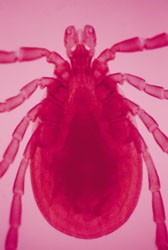U.S. Lyme Disease Cases on the Rise:
How to Avoid This Dangerous Tick-Borne Illness

Most cases of Lyme disease occur in the late spring and summer months, when ticks are most active and people spend the most time outdoors. |
Lyme disease, a tick-borne illness that can cause rash, body aches and even temporary paralysis, has been growing in the United States.
In the most recent year for which data is available, 27,444 cases of Lyme disease were reported compared to under 9,000 in 1993.
Lyme disease is caused by a bacterium called Borrelia burgdorferi, which is carried primarily by black-legged ticks (also known as deer ticks). If an infected tick bites you (ticks feed on blood and will attach to a host, including mice, cats, dogs or humans), it can transfer the bacteria through your skin and into your bloodstream.
Though anyone can get Lyme disease, you are most at risk if you spend a lot of time in wooded or grassy areas where ticks thrive. In the United States deer ticks in particular are most common in the Northeast and Midwest, along with northwestern states like Oregon and Washington.
Symptoms of Lyme Disease
In up to 80 percent of cases, the first sign of Lyme disease is a circular rash that begins at the site of the tick bite (after about three to 30 days). The rash typically widens slowly over the course of several days. Some people also experience:
- Fatigue
- Chills
- Fever
- Headache
- Muscle and joint aches
- Swollen lymph nodes
If left untreated, the infection can spread throughout your body causing more severe symptoms that include:
- Bell’s palsy (the loss of muscle tone on one or both sides of your face)
- Headaches and neck stiffness due to meningitis
- Heart palpitations
- Joint pain
- Dizziness
|
Keep Ticks Away Safely Regular tick control products contain a dangerous mix of pesticides and chemicals that can harm your pet, your environment, and your family. All-Natural products such as those on ingredients labels made from enzyme-based formulas where available are ideal alternatives. |
Although these symptoms often resolve without treatment, about 60 percent of people with untreated Lyme disease experience arthritis and severe joint pain and swelling. And in about 5 percent of cases, chronic neurological symptoms may develop, including numbness or tingling in your hands or feet and problems with concentration and short-term memory.
How to Prevent Lyme Disease
If you eliminate the cause then there is no need for a cure, and in the case of Lyme disease the “cause” is a tick bite. So you can drastically reduce your chances of getting Lyme disease by taking the following precautions to avoid exposure to ticks:
- Avoid tick-infested areas. Many parks and health departments have information about tick infestations.
- Protect your pets too. AVOID using conventional flea and tick treatments on your pets that contain harmful pesticides or chemicals, such as DEET, pyrethrins, synthetic pyrethroids or permethrin, all of which can be harmful and irritating to your pet, the person applying them and our environment.
- Keep your yard well maintained, trimmed and mowed. This will help to keep ticks away.
- Wear long sleeves and pants. When hiking or spending any amount of time in nature, you should cover your arms and legs, and tuck your pants into your socks. This will make it much harder for a tick to attach itself to you.
What to do if You’ve Been Bitten by a Tick and Suspect You Have Lyme Disease
Keep in mind that just because you’ve been bitten by a tick it does not mean you’ll get Lyme disease. Only certain types of ticks carry Lyme disease, and of those only a minority carries the bacteria.
You should see your doctor immediately if you’ve been bitten by a tick and experience signs of Lyme disease because it is imperative to begin aggressive treatment in the initial stages. Acute Lyme disease will typically be aggressively treated with antibiotics. Intravenous antibiotic therapy is typically used in acute Lyme disease, especially when it is unresponsive to oral therapy, and in chronic or recurrent cases of Lyme disease. Complementary support with natural supplements may be used with drug therapy to fight effects of both acute and chronic cases of Lyme disease. Supportive supplements for both types of Lyme disease target enhancement of the immune system.
Note that ticks can also transmit other diseases aside from Lyme disease, such as Rocky Mountain spotted fever, anaplasmosis, Tularemia and Colorado tick fever, so it is wise to make sure your doctor checks for and rules those out as well.
Sources
U.S. CDC, Division of Vector-Borne Infectious Diseases, Lyme Disease






